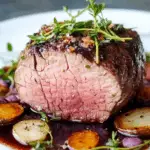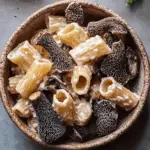Southern Sweet Tea is a cherished beverage in the Southern United States, often referred to as the “house wine of the South.” This recipe yields a perfectly sweet and smooth tea every time, thanks to a simple tip: adding a pinch of baking soda to reduce bitterness and cloudiness. Ideal for warm days, family gatherings, or any occasion that calls for a refreshing drink.
Full Recipe:
Ingredients
- 3 family-size tea bags (e.g., Luzianne or Lipton)
- 2 cups granulated sugar (adjust to taste)
- 1 gallon water, divided
- ¼ teaspoon baking soda (optional, reduces bitterness)
Directions
- Boil ½ gallon (8 cups) of water in a pot.
- Once boiling, pour the water into a 1-gallon pitcher.
- Add the 3 tea bags and ¼ teaspoon of baking soda to the pitcher. Ensure the tea bags are submerged; no need to stir.
- Let the tea steep for 15 minutes.
- After steeping, remove the tea bags without squeezing them; allow them to drip for a minute before discarding.
- Add the 2 cups of sugar to the hot tea and stir until fully dissolved.
- Pour in the remaining ½ gallon (8 cups) of cold water and stir to combine.
- Refrigerate until completely chilled.
- Serve over ice.
Nutrients
Per serving (assuming 16 servings per gallon):
- Calories: 97
- Carbohydrates: 25g
- Sugars: 25g
- Sodium: 29mg
The History and Cultural Significance of Southern Sweet Tea
Southern Sweet Tea is more than just a refreshing beverage; it’s a cultural icon deeply rooted in the traditions of the American South. Often called the “house wine of the South,” sweet tea holds a special place in Southern hospitality and daily life. The origins of sweet tea trace back to the 19th century when tea was introduced to America. However, it wasn’t until the invention of granulated sugar and the widespread availability of ice that sweet tea became the beloved staple it is today.
Sweet tea represents warmth, community, and relaxation. It’s a drink served at family gatherings, church socials, picnics, and barbecues. The act of brewing and sharing sweet tea is symbolic of Southern friendliness and hospitality. Many Southerners have their own secret variations or family recipes that have been passed down for generations, making each batch unique.
Why Is Baking Soda Added to Southern Sweet Tea?
A special tip used in authentic Southern Sweet Tea recipes is the addition of baking soda. This may sound unusual for a tea recipe, but baking soda plays a vital role in enhancing the flavor and appearance of the tea. When brewing strong black tea, natural tannins can cause bitterness and cloudiness. Baking soda acts as a mild alkaline agent that neutralizes these tannins, resulting in a smoother, less bitter taste and a clearer, more appealing color.
Not only does this technique improve the taste, but it also gives the tea that signature rich amber hue that many associate with high-quality Southern sweet tea. This simple addition is one of the secrets behind achieving a perfectly balanced tea without harshness or astringency.
The Role of Sugar in Southern Sweet Tea
Sugar is the defining ingredient that distinguishes sweet tea from regular iced tea. The traditional Southern recipe uses a generous amount of granulated sugar, which is fully dissolved into the hot tea after steeping. The amount of sugar can vary based on personal preference, but it is typically quite sweet compared to most other iced teas served around the world.
The sweetness is what makes Southern Sweet Tea so refreshing and thirst-quenching, especially in hot and humid climates. The sugar also helps balance the natural bitterness of the tea leaves, creating a harmonious blend of flavors. For those looking for alternatives, honey or simple syrup can sometimes be used, but granulated sugar remains the classic choice for that authentic Southern taste.
Tea Varieties Used in Southern Sweet Tea
The best Southern Sweet Tea starts with the right kind of tea. Traditionally, strong black teas such as Luzianne or Lipton are preferred because they produce a robust flavor that stands up well to the sugar and ice. These teas are typically bagged in family-size portions, which are perfect for brewing a large pitcher.
Black tea varieties used for sweet tea are chosen for their bold, full-bodied flavor and their ability to maintain taste even when chilled. While some people experiment with green or herbal teas, the iconic Southern Sweet Tea is almost always made with black tea due to its depth and richness.
Serving Southern Sweet Tea
Southern Sweet Tea is best served ice-cold, poured over a generous amount of ice. This chilling makes it incredibly refreshing on hot summer days, picnics, or after outdoor activities. It’s often garnished simply with a slice of lemon for a slight citrus tang, though purists prefer it plain.
The tea is commonly served in tall glasses or mason jars, which add to the rustic Southern charm. It pairs wonderfully with classic Southern dishes like fried chicken, barbecue ribs, collard greens, and cornbread. Because of its sweetness and strength, it also works as a great thirst quencher for long afternoons spent outdoors.
Health Considerations
While Southern Sweet Tea is delicious, it’s important to recognize that it is a sugary beverage. A typical serving contains a significant amount of sugar, which means it should be enjoyed in moderation, especially for those monitoring their sugar intake or managing conditions like diabetes.
On the positive side, black tea itself contains antioxidants known as flavonoids, which have been associated with various health benefits, including improved heart health and reduced inflammation. The antioxidants remain present even in sweetened tea, making it a better choice than many artificially flavored or carbonated drinks.
For those seeking a healthier version, the amount of sugar can be reduced, or natural sweeteners like stevia can be used as alternatives. Unsweetened iced tea is also an option, though it lacks the distinctive sweetness that defines Southern Sweet Tea.
How to Store Southern Sweet Tea
Proper storage is key to maintaining the freshness and flavor of Southern Sweet Tea. Because it contains sugar, it should always be refrigerated and consumed within a few days to prevent fermentation or spoilage. When stored in a sealed container, the tea retains its flavor well and stays refreshing for up to three to four days.
It’s best to avoid leaving sweet tea out at room temperature for extended periods, especially in warm weather. If preparing large batches for parties or events, it’s recommended to keep the tea chilled and replenish ice as needed to maintain optimal flavor and temperature.
Variations and Modern Twists
Though traditional Southern Sweet Tea remains a favorite, modern variations have emerged that incorporate additional flavors or healthier substitutions. Popular twists include:
-
Adding fresh mint leaves or herbs for a refreshing aroma
-
Infusing the tea with fruits like peaches, berries, or citrus slices
-
Using flavored syrups such as vanilla or hibiscus for a gourmet touch
-
Preparing sweet tea cocktails by combining the tea with spirits like bourbon or vodka
These creative adaptations showcase the versatility of sweet tea, allowing it to fit different occasions and palates while honoring its Southern roots.
Conclusion
Southern Sweet Tea is a timeless symbol of Southern culture and hospitality. Its distinctive sweet flavor, strong tea base, and simple preparation make it a beloved beverage across generations. Whether served at family gatherings, church socials, or backyard barbecues, this tea brings people together and offers a refreshing respite from the heat.
While the sugar content means it should be consumed mindfully, Southern Sweet Tea remains a delightful treat that embodies the warmth and friendliness of the South. By understanding its history, preparation nuances like the addition of baking soda, and cultural significance, you can truly appreciate why this humble tea has earned such an esteemed place in American culinary tradition.






